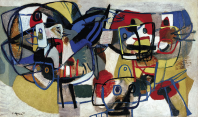Abstract
This article investigates the 'allegorical hunt of the unicorn' in late medieval visual and narrative art. The existence of the unicorn in biblical lore is an important factor in how the unicorn has been integrated into Christian symbolism. By expanding the narrative connection between hunting, virginity, and taming provided by Physiologus, the allegorical interpretations turn the taming of the wild unicorn into signifying the incarnation of Christ. This influential interpretation enables an overlaying of allegorical meanings in various media. In this process, knowledge is organized into clusters of meaning in which the creature functions as a dynamic reservoir of knowledge. This perspective allows for a deeper understanding of the functions of animals (or more specifically, human-animal relations) in medieval Christian interpretation.
Except where otherwise noted, the content of this site is licensed under a Creative Commons Attribution-ShareAlike 4.0 International (CC BY-SA 4.0).
Authors retain copyright of their work. The CC BY-SA 4.0 licence allows readers to copy and redistribute the material in any medium or format, and to remix, transform, and build upon the material for any purpose, even commercially, as long as the original author is credited and as long as any works that are derived from the original are distributed under the same terms.

